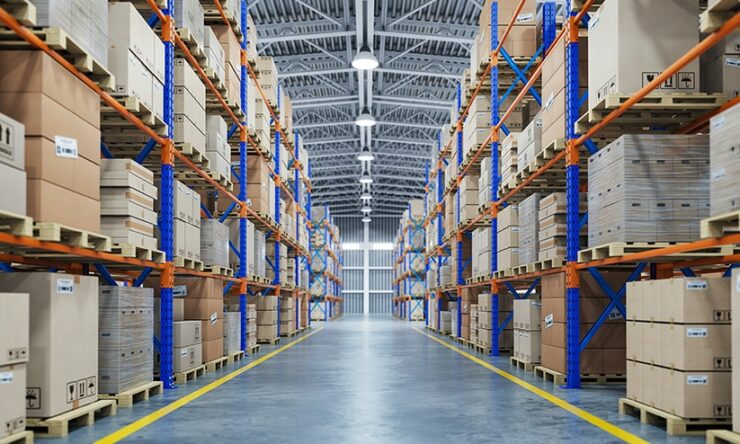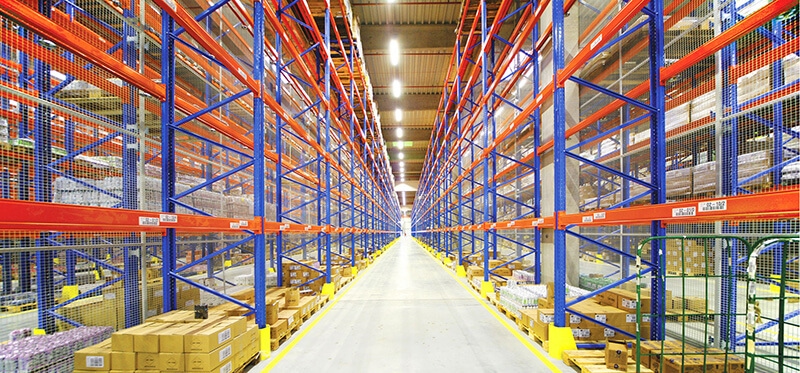A well-designed lighting system can have a significant impact on the functionality and appearance of a warehouse. In this blog post, we’ll explore key considerations to keep in mind when designing a warehouse lighting system that is both energy-efficient and effective for your needs.
Table of Contents
Key Considerations
- Lighting Levels
The first consideration when designing a warehouse lighting system is determining the appropriate lighting levels for the space. This can be determined by the type of work being done in the warehouse, as well as the layout of the space. In general, higher lighting levels are needed for detailed work like reading labels or identifying small parts, while lower lighting levels may be sufficient for spaces used primarily for storage.
The industry standard for lighting levels in a warehouse is around 500 lux for general lighting, and 750 lux for detailed work. However, it’s important to consider your specific needs and adjust the lighting levels accordingly. Factors like the height of the ceiling, the color of the walls and floors, and the size of the space can all affect the lighting levels needed.
-
Energy Efficiency
Energy-efficient lighting not only saves your warehouse money on utility bills, but it’s also better for the environment. LED lighting is a popular choice for warehouses because it uses less energy than traditional lighting sources like fluorescent or HID bulbs, and it has a longer lifespan. Additionally, LED lighting can be combined with sensors and controls to further reduce energy consumption.
One way to improve energy efficiency in your warehouse is by using motion sensors to turn off lights when they are not needed. This can be particularly useful in areas like storage rooms, where the lights are often left on for long periods of time despite no one being in the room. Another option is to use daylight harvesting, which uses sensors to automatically adjust the lighting levels based on the amount of natural light in the space.
-
Color Temperature
The color temperature of your warehouse lighting can have a significant impact on the mood and productivity of your employees. Cool white lighting (4000K-5000K) can help increase alertness and productivity, while warm white lighting (2700K-3000K) can create a more relaxed atmosphere. The choice of color temperature will depend on the type of work being done in the warehouse, as well as personal preference.
In addition to color temperature, it’s also important to consider the color rendering index (CRI) of your lighting. The CRI measures how accurately the lighting source reveals colors compared to natural light. A higher CRI (90 or above) is generally preferred in a warehouse setting, as it can help employees better distinguish between colors and identify any quality control issues.
-
Lighting Design
The design of your lighting system can affect both the appearance and functionality of your warehouse. A well-designed lighting system can enhance safety and visibility, and it can also improve the overall aesthetic of your space.
When designing your warehouse lighting system, it’s important to consider the placement and spacing of fixtures, the direction of light, and the use of dimmers and controls. Lighting fixtures should be placed strategically to ensure that they provide adequate coverage for the space. The direction of light can also affect visibility in the warehouse. For example, using fixtures that shine the light toward the ceiling can help reduce glare and create a more even distribution of light.
Dimmers and controls can also be useful in a warehouse setting. They allow you to adjust the lighting levels based on the needs of the space, and they can also help extend the lifespan of your lighting fixtures.
-
Maintenance
Proper maintenance is key to ensuring that your lighting system continues to function optimally over time. This includes regular cleaning of fixtures to remove dust and debris that can accumulate on them, replacement of burned-out bulbs, and monitoring of electrical components to ensure they are functioning correctly. By conducting regular maintenance on your lighting system, you can help extend the lifespan of your fixtures and reduce the likelihood of unexpected failures or malfunctions.
Additionally, it’s important to have a plan in place for addressing any issues that arise with your lighting system, such as flickering or dimming lights. Regular maintenance can also help ensure that your warehouse lighting system remains energy-efficient, as dust and debris on fixtures can reduce the amount of light output and increase energy consumption.
-
Lighting Uniformity
In addition to lighting levels, it’s important to consider lighting uniformity when designing your warehouse lighting system. Uniform lighting levels throughout the space can help prevent areas of shadow or glare that could affect visibility and safety. To achieve uniform lighting, it’s important to space out your lighting fixtures evenly and position them strategically to ensure adequate coverage.
-
Emergency Lighting
Emergency lighting is a critical aspect of any warehouse lighting system. In the event of a power outage or other emergency, emergency lighting can help employees safely exit the building. Emergency lighting should be positioned near exits and other key areas of the warehouse, and it should be tested regularly to ensure that it’s functioning properly.
-
Regulatory Requirements
Finally, it’s important to consider any regulatory requirements for warehouse lighting in your industry. OSHA, for example, has specific requirements for the lighting levels in different areas of a warehouse, as well as for emergency lighting and exit signage. It’s important to familiarize yourself with these requirements and ensure that your lighting system is in compliance.
Conclusion
Warehouse lighting is a critical aspect of any warehouse’s functionality and safety. Proper lighting levels, energy efficiency, and color temperature are important considerations when designing a lighting system for your warehouse. Additionally, lighting design and maintenance are key factors that can affect both the appearance and functionality of your space. By considering these key factors, you can create an efficient and effective warehouse lighting system that improves productivity and safety while reducing energy consumption and costs.



